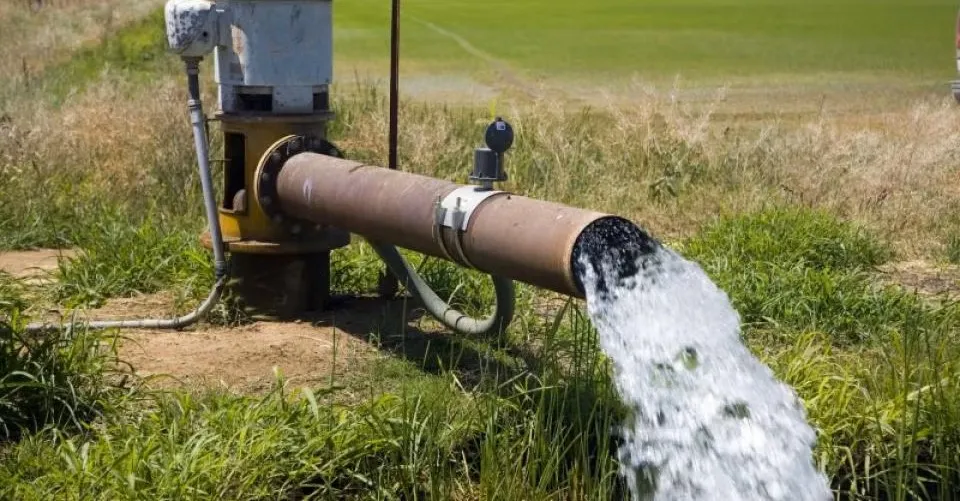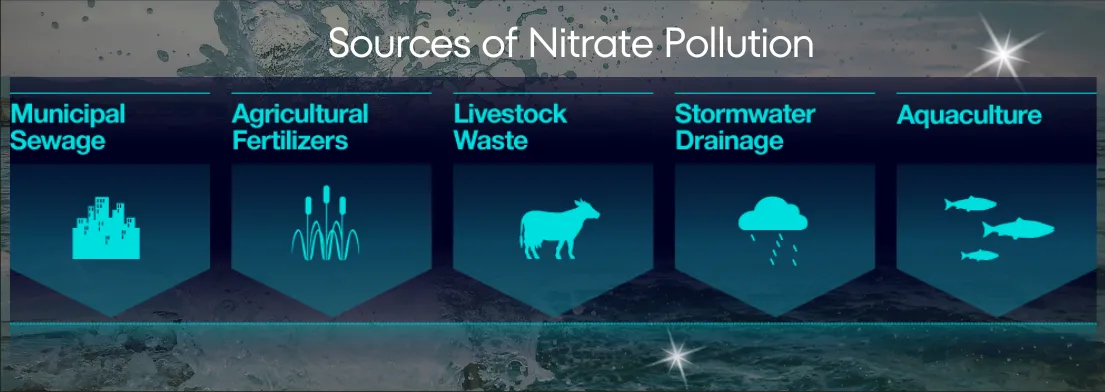Image  Groundwater nitrate contamination poses serious threats to the health of communities that rely on groundwater for their drinking water supply. Elevated nitrate in drinking water has long been identified as causing methemoglobinemia (blue baby syndrome) in infants, and the EPA drinking water standard for nitrate has accordingly been set to 10 ppm (epa.gov). However, more recent medical studies have demonstrated relationships between drinking water nitrate and a number of other health issues, including colorectal cancer, thyroid disease, and neural tube defects (Ward et al. 2018, Tariqi & Naughton 2021). Many of these studies found that the risk of these outcomes increased with ingestion of drinking water with nitrate concentrations that were below regulatory limits (i.e., lower than 10 ppm) (Ward et al. 2018). Groundwater extracted from public supply wells is typically treated at a water treatment plant to remove contaminants like nitrate before delivery to households. However, many community water systems that rely in part or fully on domestic groundwater wells deliver drinking water that is untreated or only partially treated to remove contaminants. Low-income communities face disproportionate vulnerability to drinking water contaminated with nitrate (Schaider et al. 2019). California’s San Joaquin Valley (SJV), which has some of the poorest communities in the US, is heavily reliant on groundwater for drinking and has some of the highest groundwater nitrate contamination in the US (Balazs et al. 2011). Despite living on only 14% of California’s land area and constituting 24% of California’s population, a 2021 study found that 41% of nitrate well contamination hot spots in California were located in disadvantaged communities, as defined by the California Office of Environmental Health Hazard Assessment (OEHHA) scoring (Tariqi & Naughton 2021). Latinos and African Americans are more likely to live in communities impacted by the combined factors determining a community’s OEHHA score (socioeconomic factors, health sensitivities, environmental hazards) (OEHHA 2018). Disadvantaged communities in California also have higher population density and a larger number of water consumers per drinking water well, which means that a larger number of people are exposed to high levels of drinking water nitrate in these communities relative to others (Tariqi & Naughton 2021). These communities are in need of strategies to reduce nitrate loading to groundwater, but also reliable information and resources to consume drinking water safely when their groundwater is already contaminated with long legacies of nitrate loading. For many of the reasons outlined above, distrust in tap water can be a pervasive problem in disadvantaged communities, causing negative economic and health consequences as residents reduce tap water consumption and increase consumption of bottled beverages, usually sugar-sweetened beverages (Gonzalez et al. 2023). Exploratory research by the Luskin Center at UCLA documented fear of drinking tap water among caregivers and parents in SJV (specifically, in Kern County), and recommended that “trusted community-based organizations and public agencies conduct research-informed public education campaigns and tap water testing programs” to assist communities with tap water concerns (Gonzales et al. 2023). Actionable strategies to reduce nitrate pollution To tackle nitrate contamination effectively, water providers need to invest in enhancing their treatment capabilities. Upgrading existing infrastructure to improve nitrate removal is crucial. This could mean investing in cutting-edge technologies like anion exchange or reverse osmosis systems, which can target even low nitrate concentrations. By ensuring that all public supply wells are equipped with effective treatment systems, we can go a long way in safeguarding the health of our communities (Balazs et al., 2011). Disadvantaged communities often face unique funding hurdles when it comes to remediating nitrate contamination. Local governments and NGOs should prioritize creating financial support for home water filtration systems to improve equitable access to safe drinking water for everyone (Tariqi & Naughton, 2021). In addition to strategies to remove nitrate from drinking water, we will need to stop new contributions to drinking water nitrate pollution at its source. Agricultural activities can contribute significantly to groundwater nitrate pollution. The extent of agricultural land and reliance on groundwater for drinking water sources have both been significantly associated with nitrate concentrations in drinking water (Schaider et al. 2019). A 2012 report on two groundwater basins in the SJV (Tulare Lake Basin and Salinas Valley) found that 96% of nitrate loading to groundwater was from cropland (Harter et al. 2012). Policymakers could play a critical role in combating nitrate pollution by developing and enforcing regulations that limit the use of excess nitrate fertilizer in agriculture. Farmers can implement best management practices (BMPs) such as crop rotation, cover cropping, and nitrification inhibitors to reduce the amount of nitrate entering groundwater (Schaider et al., 2019). Providing financial incentives for farmers who adopt these sustainable practices can encourage compliance and help create safer drinking water resources for farming communities.  Ongoing research into the sources and impacts of nitrate contamination paired with effective communication to groundwater consumers is vital. Collaborations between universities and water agencies can facilitate groundwater nitrate monitoring, helping to pinpoint pollution hotspots. Outreach efforts should focus on informing residents about where to find monitoring data and how to interpret it. Residents should also be informed on the risks associated with high nitrate levels in drinking water and the importance of participating in tap water testing programs. These partnerships not only enable timely interventions but also raise community awareness about water quality (Gonzalez et al., 2023). Additionally, rebuilding trust between residents and water providers is essential for effectively addressing water quality concerns. Collaborating with trusted local organizations can significantly enhance outreach effectiveness and promote a collective approach to water safety (Gonzales et al., 2023). Providers should supply regular updates (e.g., through newsletters) and host community forums on drinking water quality, which can empower residents to seek accurate information and voice their concerns. Water agencies can also invest in enlisting organizations like UC Cooperative Extension that have the capacity and experience to share science-based knowledge with residents. A united and community-engaged effort among water providers, regulators, and researchers is essential for advocating for stronger environmental protections at both the state and federal levels. Collaborative initiatives that bring together multiple stakeholders can amplify efforts to address broader environmental justice issues related to water quality (Schaider et al., 2019). While our list of strategies is not exhaustive, it provides an initial set of guidelines to make significant progress in tackling nitrate contamination in drinking water. Ultimately, this will contribute to a healthier future for all, particularly for those in disadvantaged communities. Literature Cited Balazs, C.; R. Morello-Frosch; A. Hubbard; and I. Ray. 2011. Social disparities in nitrate-contaminated drinking water in California’s San Joaquin Valley. Environmental Health Perspectives, 119: 1272-1278. California Office of Environmental Health Hazard Assessment (OEHHA). 2018. Available at: https://oehha.ca.gov/calenviroscreen/report/calenviroscreen-30 (accessed February 27, 2025). González, S.R.; A. Hernandez; and G. Pierce. 2023. Fear at the Tap: Factors contributing to public drinking water distrust in Latino communities – results from exploratory research in Kern County. UCLA Latino Policy & Politics Institute, Luskin Center for Innovation. Harter, T.; J.R. Lund; J. Darby; G.E. Fogg; R. Howitt; K.K. Jessoe; G.S. Pettygrove; J.F. Quinn; J.H. Viers; D.B. Boyle; H.E. Canada; N. DeLaMora; K.N. Dzurella; A. Fryjoff-Hung; A.D. Hollander; K.L. Honeycutt; M.W. Jenkins; V.B. Jensen; A.M. King; G. Kourakos; D. Liptzin; E.M. Lopez; M.M. Mayzelle; A. McNally; J. Medellin-Azuara; and T.S. Rosenstock. 2012. Addressing Nitrate in California’s Drinking Water with a Focus on Tulare Lake Basin and Salinas Valley Groundwater. Report for the State Water Resources Control Board Report to the Legislature. Center for Watershed Sciences, University of California, Davis. 78 p. http://groundwaternitrate.ucdavis.edu. Schaider, L.A.; L. Swetschinski; C. Campbell; and R.A. Rudel. 2019. Environmental justice and drinking water quality: are there socioeconomic disparities in nitrate levels in U.S. drinking water? Environmental Health, 18: 3. doi: 10.1186/s12940-018-0442-6 Tariqi, A.O. and C.C. Naughton. 2021. Water, health, and environmental justice in California: Geospatial analysis of nitrate contamination and thyroid cancer. Environmental Engineering, 38: https://doi.org/10.1089/ees.2020.0315 Ward, M.H.; R.R. Jones; J.D. Brender; T.M. De Kok; P.J. Weyer; B.T. Nolan; C.M. Villanueva; and S.G. Van Breda. 2018. Drinking water nitrate and human health: An updated review. International Journal of Environmental Research and Public Health, 15: 10.3390/ijerph15071557
Want more water equity and community stories?
👉 Subscribe to our blog for updates on local programs and events related to water equity. |
Pure Water Matters - Your Essential Guide to Drinking Water Quality!

